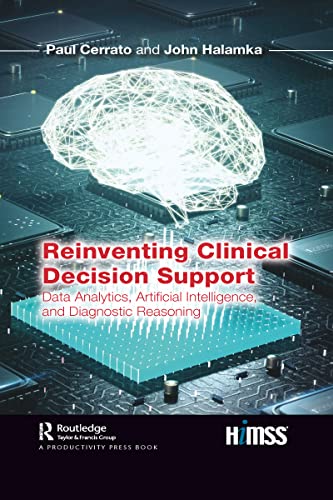Verwandte Artikel zu Reinventing Clinical Decision Support: Data Analytics,...
Reinventing Clinical Decision Support: Data Analytics, Artificial Intelligence, and Diagnostic Reasoning (HIMSS Book Series) - Softcover

Zu dieser ISBN ist aktuell kein Angebot verfügbar.
Alle Exemplare der Ausgabe mit dieser ISBN anzeigen:- VerlagTaylor & Franci
- Erscheinungsdatum2021
- ISBN 10 1032081856
- ISBN 13 9781032081854
- EinbandTapa blanda
- Auflage1
- Anzahl der Seiten184
Neu kaufen
Mehr zu diesem Angebot erfahren
Versand:
EUR 2,47
Innerhalb der USA
Beste Suchergebnisse bei AbeBooks
Reinventing Clinical Decision Support : Data Analytics, Artificial Intelligence, and Diagnostic Reasoning
Buchbeschreibung Zustand: New. Bestandsnummer des Verkäufers 42911616-n
Weitere Informationen zu diesem Verkäufer | Verkäufer kontaktieren
Reinventing Clinical Decision Support (HIMSS Book Series)
Buchbeschreibung Zustand: New. Book is in NEW condition. Bestandsnummer des Verkäufers 1032081856-2-1
Weitere Informationen zu diesem Verkäufer | Verkäufer kontaktieren
Reinventing Clinical Decision Support (HIMSS Book Series)
Buchbeschreibung Zustand: New. New! This book is in the same immaculate condition as when it was published. Bestandsnummer des Verkäufers 353-1032081856-new
Weitere Informationen zu diesem Verkäufer | Verkäufer kontaktieren
Reinventing Clinical Decision Support: Data Analytics, Artificial Intelligence, and Diagnostic Reasoning
Buchbeschreibung Paperback / softback. Zustand: New. This item is printed on demand. New copy - Usually dispatched within 5-9 working days. Bestandsnummer des Verkäufers C9781032081854
Weitere Informationen zu diesem Verkäufer | Verkäufer kontaktieren
Reinventing Clinical Decision Support (HIMSS Book Series)
Buchbeschreibung Zustand: New. Bestandsnummer des Verkäufers ABLIING23Mar2317530210046
Weitere Informationen zu diesem Verkäufer | Verkäufer kontaktieren
Reinventing Clinical Decision Support: Data Analytics, Artificial Intelligence, and Diagnostic Reasoning
Buchbeschreibung Paperback / softback. Zustand: New. New copy - Usually dispatched within 4 working days. Bestandsnummer des Verkäufers B9781032081854
Weitere Informationen zu diesem Verkäufer | Verkäufer kontaktieren
Reinventing Clinical Decision Support
Print-on-DemandBuchbeschreibung PAP. Zustand: New. New Book. Shipped from UK. THIS BOOK IS PRINTED ON DEMAND. Established seller since 2000. Bestandsnummer des Verkäufers L0-9781032081854
Weitere Informationen zu diesem Verkäufer | Verkäufer kontaktieren
Reinventing Clinical Decision Support: Data Analytics, Artificial Intelligence, and Diagnostic Reasoning
Buchbeschreibung Paperback. Zustand: Brand New. 164 pages. 9.00x6.00x0.25 inches. In Stock. Bestandsnummer des Verkäufers __1032081856
Weitere Informationen zu diesem Verkäufer | Verkäufer kontaktieren
Reinventing Clinical Decision Support (HIMSS Book Series)
Buchbeschreibung Zustand: New. Bestandsnummer des Verkäufers I-9781032081854
Weitere Informationen zu diesem Verkäufer | Verkäufer kontaktieren
Reinventing Clinical Decision Support: Data Analytics; Artificial Intelligence; and Diagnostic Reasoning
Buchbeschreibung Zustand: New. PRINT ON DEMAND Book; New; Fast Shipping from the UK. No. book. Bestandsnummer des Verkäufers ria9781032081854_lsuk
Weitere Informationen zu diesem Verkäufer | Verkäufer kontaktieren

